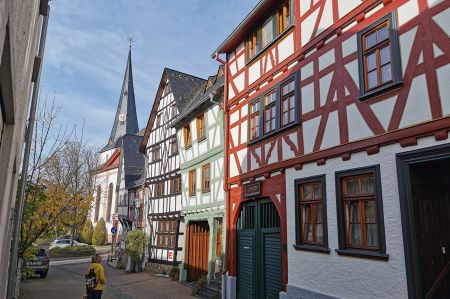Tour through the old town of Bad Camberg
- Written by Portal Editor
Our tour of Bad Camberg quickly showed that the place has much more to offer than water, fresh air and a beautiful landscape. The small town always surprises with many picturesque and unusual buildings.
The Camberger Amthof, already described, is the most striking because it is the largest. Only remnants of the former city fortifications remain. With the Obertorturm (32 meters high, built around 1380) and the Untertorturm (built between 1365 and 1380), two of the former 13 towers are still standing.
Leaning Tower of Bad Camberg
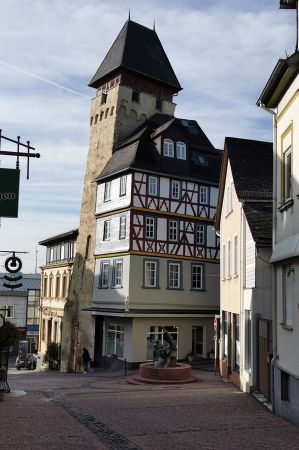 Adjacent to the Amthof you will find the Obertorturm, also a landmark of the city, which also appears in the city coat of arms. Right next to it is the Hohenfeld Chapel. The chapel is furnished with numerous furnishings from different centuries, including plaques with epitaphs from the families of Metternich and Hohenfeld, von Schütz zu Holzhausen, von Bechtolsheim and Spies von Büllesheim, who were important for the city. Today the Obertorturm and Hohenfeldkapelle serve as a town and tower museum.
Adjacent to the Amthof you will find the Obertorturm, also a landmark of the city, which also appears in the city coat of arms. Right next to it is the Hohenfeld Chapel. The chapel is furnished with numerous furnishings from different centuries, including plaques with epitaphs from the families of Metternich and Hohenfeld, von Schütz zu Holzhausen, von Bechtolsheim and Spies von Büllesheim, who were important for the city. Today the Obertorturm and Hohenfeldkapelle serve as a town and tower museum.
The Untertorturm is popularly known as the "Leaning Tower of Bad Camberg". The tower owes its name to an inclination of 1.44 meters at a height of 21 meters. At its base there were once three gates in a row. Its old hood was destroyed in the final stages of World War II in 1945.
In honor of the apostles Peter and Paul
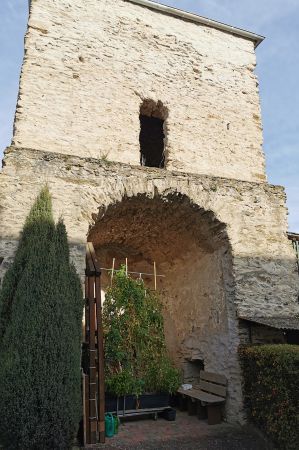 The Catholic Church of St. Peter and Paul rises prominently above the old town on a steep slope to the south. A St. Peter's Church in Camberg was first mentioned in a document from 1156. The oldest part of today's church is the tower, built in 1580. The main building of the church was then built in 1781. Worth mentioning in the side altar is the crescent moon Madonna, a Rhenish-Franconian work of art, probably made around 1525. After the nave fell into disrepair in the 18th century, a new church had to be built. It was built in the Zopf style by the Dillenburg building inspector Johann Friedrich Sckell, making it one of the few examples of this type of construction in the region. The electoral auxiliary bishop Johannes Maria von Herbain consecrated the church on July 15, 1781 in honor of the apostles Peter and Paul.
The Catholic Church of St. Peter and Paul rises prominently above the old town on a steep slope to the south. A St. Peter's Church in Camberg was first mentioned in a document from 1156. The oldest part of today's church is the tower, built in 1580. The main building of the church was then built in 1781. Worth mentioning in the side altar is the crescent moon Madonna, a Rhenish-Franconian work of art, probably made around 1525. After the nave fell into disrepair in the 18th century, a new church had to be built. It was built in the Zopf style by the Dillenburg building inspector Johann Friedrich Sckell, making it one of the few examples of this type of construction in the region. The electoral auxiliary bishop Johannes Maria von Herbain consecrated the church on July 15, 1781 in honor of the apostles Peter and Paul.
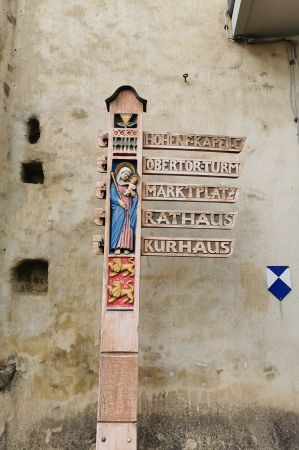 The red-brick Protestant St. Martin's Church and the vicarage were built in 1896-1897 under Pastor Ernst for the entire area of the Goldenen Grund. In order to receive state subsidies for the construction costs, the congregation had to coordinate a lengthy, complex process with the state building authorities on the one hand and the church institutions on the other.
The red-brick Protestant St. Martin's Church and the vicarage were built in 1896-1897 under Pastor Ernst for the entire area of the Goldenen Grund. In order to receive state subsidies for the construction costs, the congregation had to coordinate a lengthy, complex process with the state building authorities on the one hand and the church institutions on the other.
The design that was finally approved came from government and building councilor Hermann Eggert (at that time lecturer for church building at the Prussian Ministry of Public Works in Berlin), while the Herborn architect Ludwig Hofmann, who was already experienced in Protestant sacred building, exercised the construction management under the supervision of the Wiesbaden district government. For the inauguration, Empress Auguste Viktoria gave the congregation an altar Bible.
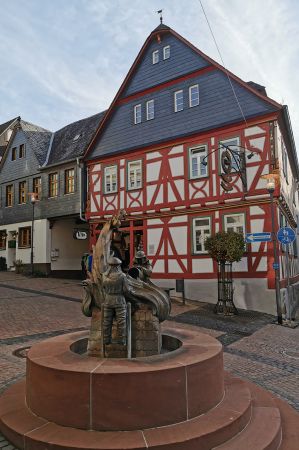 Also from the 19th century are the former branch of the Dernbach sisters on Frankfurter Strasse, known as the little monastery, and the town hall on the Kurpark, which we will visit later.
Also from the 19th century are the former branch of the Dernbach sisters on Frankfurter Strasse, known as the little monastery, and the town hall on the Kurpark, which we will visit later.
Another important half-timbered building is the old pharmacy, the foundations of which date back to 1330 and which were rebuilt in 1492 as the Burgmannenhaus of the von Hattsteins. The house has housed a pharmacy since 1663. Today's Guttenberger Hof was first mentioned in 1336 as the seat of the von Hattstein family.
It was rebuilt in its current form in 1526. In 1767 the estate changed hands to the von Guttenberg family and in 1820 to bourgeois ownership. The Guttenberger Hof is currently (October 2007) being renovated.
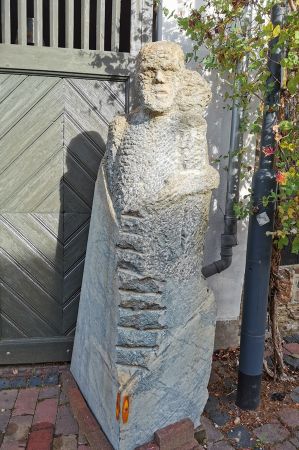 A landmark not only for Bad Camberg, but for the entire Goldener Grund, the Cross Chapel is located outside the old town on a small hill. A first chapel was built as early as 1682 and then extended in 1725 to give today's cross-shaped floor plan.
A landmark not only for Bad Camberg, but for the entire Goldener Grund, the Cross Chapel is located outside the old town on a small hill. A first chapel was built as early as 1682 and then extended in 1725 to give today's cross-shaped floor plan.
A path with the 14 Stations of the Cross leads from Bad Camberg up to the Cross Chapel.
From here you have a wide view over the Goldener Grund into the Limburg Basin and the mountains of the Hochtaunus.
The landmarks of the more than 1000-year-old town of Bad Camberg include the well-preserved Obertor and Untertor towers. In the old town of Bad Camberg there are a number of other half-timbered houses, some of which have very elaborate ornamentation.
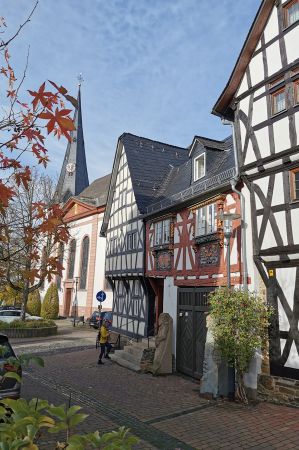 The houses were mostly built between the 15th and 18th centuries. Many of these houses are grouped around the market square, which was a trading station on the Hohe Straße from Cologne to Frankfurt, which today roughly corresponds to the course of the A 3 federal motorway near Bad Camberg. In Bad Camberg it met the old Via Publica from Brussels to Prague, the course of which is now followed by the B 8 federal highway in the Taunus.
The houses were mostly built between the 15th and 18th centuries. Many of these houses are grouped around the market square, which was a trading station on the Hohe Straße from Cologne to Frankfurt, which today roughly corresponds to the course of the A 3 federal motorway near Bad Camberg. In Bad Camberg it met the old Via Publica from Brussels to Prague, the course of which is now followed by the B 8 federal highway in the Taunus.
Please read as well:
Historical courthouse with tower museum in Bad Camberg
Thermal springs and Hundertwasserhaus in Bad Soden
-
 Hiking inside old town of Bad Camberg
Hiking inside old town of Bad Camberg
Hiking inside old town of Bad Camberg
Hiking inside old town of Bad Camberg
-
 Hiking inside old town of Bad Camberg
Hiking inside old town of Bad Camberg
Hiking inside old town of Bad Camberg
Hiking inside old town of Bad Camberg
-
 Hiking inside old town of Bad Camberg
Hiking inside old town of Bad Camberg
Hiking inside old town of Bad Camberg
Hiking inside old town of Bad Camberg
-
 Hiking inside old town of Bad Camberg
Hiking inside old town of Bad Camberg
Hiking inside old town of Bad Camberg
Hiking inside old town of Bad Camberg
-
 Hiking inside old town of Bad Camberg
Hiking inside old town of Bad Camberg
Hiking inside old town of Bad Camberg
Hiking inside old town of Bad Camberg
-
 Hiking inside old town of Bad Camberg
Hiking inside old town of Bad Camberg
Hiking inside old town of Bad Camberg
Hiking inside old town of Bad Camberg
-
 Hiking inside old town of Bad Camberg
Hiking inside old town of Bad Camberg
Hiking inside old town of Bad Camberg
Hiking inside old town of Bad Camberg
-
 Hiking inside old town of Bad Camberg
Hiking inside old town of Bad Camberg
Hiking inside old town of Bad Camberg
Hiking inside old town of Bad Camberg
-
 Hiking inside old town of Bad Camberg
Hiking inside old town of Bad Camberg
Hiking inside old town of Bad Camberg
Hiking inside old town of Bad Camberg
-
 Hiking inside old town of Bad Camberg
Hiking inside old town of Bad Camberg
Hiking inside old town of Bad Camberg
Hiking inside old town of Bad Camberg
-
 Hiking inside old town of Bad Camberg
Hiking inside old town of Bad Camberg
Hiking inside old town of Bad Camberg
Hiking inside old town of Bad Camberg
-
 Hiking inside old town of Bad Camberg
Hiking inside old town of Bad Camberg
Hiking inside old town of Bad Camberg
Hiking inside old town of Bad Camberg
-
 Hiking inside old town of Bad Camberg
Hiking inside old town of Bad Camberg
Hiking inside old town of Bad Camberg
Hiking inside old town of Bad Camberg
-
 Hiking inside old town of Bad Camberg
Hiking inside old town of Bad Camberg
Hiking inside old town of Bad Camberg
Hiking inside old town of Bad Camberg
-
 Hiking inside old town of Bad Camberg
Hiking inside old town of Bad Camberg
Hiking inside old town of Bad Camberg
Hiking inside old town of Bad Camberg
https://www.alaturka.info/en/germany/hesse/5877-tour-through-the-old-town-of-bad-camberg#sigProIdeb333830fd
